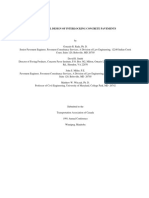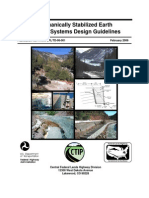02 05shoulders B
02 05shoulders B
Uploaded by
Shahnewaz RabbiCopyright:
Available Formats
02 05shoulders B
02 05shoulders B
Uploaded by
Shahnewaz RabbiOriginal Title
Copyright
Available Formats
Share this document
Did you find this document useful?
Is this content inappropriate?
Copyright:
Available Formats
02 05shoulders B
02 05shoulders B
Uploaded by
Shahnewaz RabbiCopyright:
Available Formats
No.
0092-02-05
Guidelines for Highway
Shoulder Performance
BRIEF
putting research to work
Whats the Problem?
WisDOT currently possesses little data on the performance of concrete and asphalt shoulders abutting Portland cement concrete mainline pavements, and so lacks adequate means to determine the best design choices for these shoulders. Furthermore, maintenance crews report poor performance by shoulders. Heaving and other distresses impede snow removal operations and wear plow blades unevenly. Premature cracking forces maintenance crews to rehabilitate relatively new shoulders. This constant maintenance demand exposes crews to high volume traffic and safety hazards. District maintenance staff want shoulder designs that eliminate or heavily reduce crew exposure and cold weather problems on heavy volume roadways like Interstates. Such designs cannot be formulated without clearer understanding of performance characteristics and costs associated with various shoulder design options.
Research Objectives
This research seeks to fill the data void and design uncertainty related to shoulders adjacent to concrete pavements. Specific objectives include: 1. Develop performance optimizing guidelines for selection, design and construction of
shoulders adjacent to concrete pavements;
2. Determine cost effectiveness of paved shoulders; and 3. Broaden current WisDOT knowledge of design, construction, performance, cost and
maintenance of shoulders along concrete pavements.
RESEARCH DEVELOPMENT & TECHNOLOGY TRANSFER
Research Methodology
Researchers aimed to accomplish the task through the following steps: 1. Literature review and survey of design, construction, and maintenance practices, as well as costs and performance, in Wisconsin and six surrounding states; 2. Selection and review of Wisconsin shoulder types; 3. Survey of shoulder conditions on 289 miles of roadway at 133 sites in Wisconsin; 4. Analysis of survey results and site conditions for impact of various design factors; 5. Development of new guidelines for shoulders abutting concrete pavements.
Research Results
A literature review and surveys of other states showed that WisDOT stands in a crowd of state DOTs that lack clear design and performance data for shoulders abutting concrete pavements, that struggle with premature stresses on shoulders, and that face increasing shoulder uses such as diverted traffic during mainline maintenance. States generally agree that concrete shoulders should be jointed plain concrete tied to the mainline, and that formal shoulder maintenance programs and intra-agency communication channels are needed. Concrete shoulders generally suffer slab breakup, distressed joints, and longitudinal stress; and these distresses were directly affected by shoulder base thickness. Asphalt pavements suffer a variety of cracking forms, edge raveling, heave, settlement, and longitudinal joint deterioration; and shoulder width and thickness and aggregate base types impacted these stresses. Shoulders alongside doweled, jointed concrete pavements showed significantly less stress than those alongside non-doweled concrete.
Investigators Samuel OwusuAbabio, Robert Schmitt, University of Wisconsin - Platteville
The Wisconsin Department of Transportation
Longitudinal joint deterioration severity level 2, Figure G-12.
This study gives us our first systematic look at the performance of highway shoulders. Were looking closely at the suggested guidelines for ways to improve both construction and maintenance of shouders.
- David Larson, WisDOT Pavements Section
Modeling of distress modes in shoulder types adjacent to concrete pavement requires a shift from traditional combination indices including Pavement Distress Index (PDI) and Pavement Condition Index (PCI), which produce average distress figures for various combinations, but fail to describe the specific stress effects of interest to design evaluation. This study produced a Shoulder Distress Index Factor (SDIF) that combined extent and severity of each type of stress effect for different shoulder-pavement combinations, yielding data useful for design considerations. Design guidelines for concrete shoulders include: Increase shoulder minimum base thickness to 10 inches or more. Investigate appropriate bar height for rumble strips, the site of most slab breakup. Design guidelines for asphalt shoulders include: Minimum width of eight feet for asphalt shoulders or shoulder components in composite shoulders (those with concrete bordered by asphalt). Filling of longitudinal joints between concrete and asphalt. Use of crushed aggregate base course. Increase minimum surface thickness to four inches. Changes in shoulder types and designs require life cycle cost analysis. In the case of concrete, this is particularly important for considering pavement thickness greater than 10 inches; in asphalt, minimum width and surface thickness both should be informed by such analysis, in order to assure that the increased construction cost will be balanced by reduced maintenance expense. Furthermore, researchers asserted WisDOT needed a coherent department policy regarding sealing of all longitudinal joints.
Benefits Anticipated
By implementation of the above design guidelines, WisDOT should experience extended performance life for shoulders that will experience less severe stresses. Hence, less maintenance will be required, and maintenance costs and safety risks will both diminish.
Future Research Directions
The investigators recommended further research focused on performance monitoring and mainlineshoulder design interactions.
Wisconsin Department of Transportation RD&T Program 4802 Sheboygan Ave. Madison, WI 53707 Nina McLawhorn Research Administrator 608-266-3199
Performance of Shoulders Adjacent to Concrete Pavements 0092-02-05 June 2003
Specific research directions proposed include: 1. Investigation of use of same material for both pavement and shoulder, which could reduce construction and maintenance costs and improve performance. 2. Exploration of automated data collection systems for shoulders. 3. Development of a database system for design, construction, maintenance and performance for holistic pavement systems that include both mainline and shoulders. 4. Creation of formal communication procedures between design, construction and maintenance units impacted by shoulder performance. 5. Establishment of performance and maintenance goals for shoulders of various highway classifications. 6. Exploration of reducing concrete pavement thicknesses for pavements tied to concrete shoulders; researchers speculate that well-designed concrete shoulders could provide edge support sufficient to accommodate an inch reduction in mainline thickness.
For more information, contact:
David Larson: david.larson@dot.state.wi.us
You might also like
- A Practical Guide to Concrete Pavement Technology for Developing CountriesFrom EverandA Practical Guide to Concrete Pavement Technology for Developing CountriesNo ratings yet
- TiebarDocument117 pagesTiebarpcsri1956No ratings yet
- 111 CRDocument35 pages111 CRJames McguireNo ratings yet
- UnlversDocument55 pagesUnlversCan AcarNo ratings yet
- Bridge MaintenenceDocument41 pagesBridge MaintenenceFriansyah BudiNo ratings yet
- Transverse Cracking in Concrete Bridge Decks: Cfrench@tc - Umn.eduDocument29 pagesTransverse Cracking in Concrete Bridge Decks: Cfrench@tc - Umn.eduVipin Kumar ParasharNo ratings yet
- Study of Structural Failure of Road After Widening and Its Remedial MeasuresDocument10 pagesStudy of Structural Failure of Road After Widening and Its Remedial MeasuresIJRASETPublicationsNo ratings yet
- Foundation WorksDocument27 pagesFoundation WorksDean SamuelNo ratings yet
- 111 CR PDFDocument35 pages111 CR PDFfandhiejavanov2009No ratings yet
- Highway Report 2Document30 pagesHighway Report 2Kerol Kerol Kerol100% (1)
- 1.3 Objectives and ScopeDocument10 pages1.3 Objectives and Scopemohamed ahmedNo ratings yet
- Application of Statistical Methods To The Design of Pavement SystemsDocument17 pagesApplication of Statistical Methods To The Design of Pavement SystemsBakhtiyar Q.KhawajaNo ratings yet
- Coatings: A Specified Procedure For Distress Identification and Assessment For Urban Road Surfaces Based On PCIDocument26 pagesCoatings: A Specified Procedure For Distress Identification and Assessment For Urban Road Surfaces Based On PCIHeńřÿ ŁøĵæńNo ratings yet
- Literature Review On Design of Flexible PavementDocument4 pagesLiterature Review On Design of Flexible Pavementbctfnerif100% (1)
- Bridges - All - Paper - Integral Abutments For Steel Bridges by E Wasserman - 10-1996Document44 pagesBridges - All - Paper - Integral Abutments For Steel Bridges by E Wasserman - 10-1996Xuejian LiuNo ratings yet
- 04 Artigo AASHTOWareDocument19 pages04 Artigo AASHTOWareengfelipemaia11No ratings yet
- RabiyaDocument16 pagesRabiyaZeeshan AliNo ratings yet
- Aashto Road Test1Document3 pagesAashto Road Test1Lenana KoikaiNo ratings yet
- 00 05flexibleoverlay FDocument72 pages00 05flexibleoverlay FDaniel PatiñoNo ratings yet
- Batouli 2017Document14 pagesBatouli 2017souhatroudi99No ratings yet
- 2014 MPC 459Document7 pages2014 MPC 459ramudu oneNo ratings yet
- 3D Impact Load Transfer MechanismDocument134 pages3D Impact Load Transfer Mechanismdafo407No ratings yet
- Unit Conversion TableDocument217 pagesUnit Conversion TableNull NullNo ratings yet
- Accelerated Brideg Construction in Washington StateDocument16 pagesAccelerated Brideg Construction in Washington StatesyedabdulhannanNo ratings yet
- Project Pavement Condition Survey at Parit Jelutong, Batu Pahat, JohorDocument73 pagesProject Pavement Condition Survey at Parit Jelutong, Batu Pahat, JohorMoganraj100% (3)
- 32512r 02Document32 pages32512r 02jgntrideNo ratings yet
- Tech BriefDocument4 pagesTech BriefaskarahNo ratings yet
- Research ProposalDocument10 pagesResearch ProposalshrikantharleNo ratings yet
- King Fahd University of Petroleum & Minerals: Construction Equipment and MethodsDocument13 pagesKing Fahd University of Petroleum & Minerals: Construction Equipment and MethodssyukriNo ratings yet
- A Review On Design and Analysis of Foot Over Bridge Using Plated Fabricated Steel MemberDocument5 pagesA Review On Design and Analysis of Foot Over Bridge Using Plated Fabricated Steel MemberIJRASETPublicationsNo ratings yet
- An Extension of Rigid Pavement Design MethodsDocument14 pagesAn Extension of Rigid Pavement Design MethodsBesim QelajNo ratings yet
- Concrete Pavement Design: Technical SummaryDocument2 pagesConcrete Pavement Design: Technical SummaryHaris Restu UtamaNo ratings yet
- Diseño Articulados Icpi AmericanoDocument21 pagesDiseño Articulados Icpi AmericanoHugo Arenas LozanoNo ratings yet
- Fundamental of Bridge Questions and AnswerDocument14 pagesFundamental of Bridge Questions and AnswerTadesse Megersa50% (2)
- Highway Design Principles and PracticeDocument6 pagesHighway Design Principles and Practicesekacavelle0% (1)
- Case Study: Widening An Existing Bridge Structure Challenges and SolutionsDocument8 pagesCase Study: Widening An Existing Bridge Structure Challenges and Solutionsmohammad hamdanNo ratings yet
- Study The Behaviour of Box Type Bridge With Different Height and Same Width For The IRC LoadingsDocument6 pagesStudy The Behaviour of Box Type Bridge With Different Height and Same Width For The IRC LoadingsIJRASETPublicationsNo ratings yet
- Coatings: A Specified Procedure For Distress Identification and Assessment For Urban Road Surfaces Based On PCIDocument26 pagesCoatings: A Specified Procedure For Distress Identification and Assessment For Urban Road Surfaces Based On PCIHeńřÿ ŁøĵæńNo ratings yet
- Journal Revised PDFDocument9 pagesJournal Revised PDFMary Joyce Peralta EstayaneNo ratings yet
- Design of A Flexible PavementDocument41 pagesDesign of A Flexible PavementMohammad GhouseNo ratings yet
- Comparative Analysis of Macrotexture Measurement Tests For Pavement Preservation TreatmentsDocument12 pagesComparative Analysis of Macrotexture Measurement Tests For Pavement Preservation TreatmentsAnmar Al-AdlyNo ratings yet
- Reliability BasedDocument36 pagesReliability BasedSokheng HourNo ratings yet
- CE414 02 Design FactorsDocument7 pagesCE414 02 Design FactorsMohamed Imbarek EsekbiNo ratings yet
- LRFD BridgesDocument14 pagesLRFD BridgesBeny AbdouNo ratings yet
- Bassey ProjectDocument26 pagesBassey Projectchiamakagifteze7No ratings yet
- Le VernArticle ATC AnglaisDocument19 pagesLe VernArticle ATC AnglaisMilenka Uceda PuiconNo ratings yet
- Chapter-2 Literature Review 2.1.generalDocument4 pagesChapter-2 Literature Review 2.1.generalMin Htet AungNo ratings yet
- Concrete Pavement DesignDocument3 pagesConcrete Pavement Designsyxomphous100% (1)
- Sure! Here are-WPS OfficeDocument7 pagesSure! Here are-WPS OfficekevautistaNo ratings yet
- Integral Abutment and Jointless BridgesDocument343 pagesIntegral Abutment and Jointless BridgesNurali Mamen100% (1)
- Salinan Perda Apbd MurniDocument8 pagesSalinan Perda Apbd MurniRacun BisaNo ratings yet
- Urban and Regionnal Planning StudiesDocument14 pagesUrban and Regionnal Planning Studiesoloyeded405No ratings yet
- Fake 2Document4 pagesFake 2lenanaNo ratings yet
- Anchorage Zone Design For Pretension Ed Precast Bulb-T BridgeDocument75 pagesAnchorage Zone Design For Pretension Ed Precast Bulb-T BridgeDan LeNo ratings yet
- 2 Design FactorsDocument7 pages2 Design FactorsshurookNo ratings yet
- Flexible Pavement Test Sections For Studying Pavement DesignDocument8 pagesFlexible Pavement Test Sections For Studying Pavement DesignGladson JsNo ratings yet
- State of The Art Rigid Pavement DesignDocument7 pagesState of The Art Rigid Pavement DesignarenasjoseNo ratings yet
- MSE Wall Design ManualDocument230 pagesMSE Wall Design Manualnicholas_terzisNo ratings yet
- Manual for Climate Change Adaptation Measures for Transport Infrastructure in Central Asia with a Focus on UzbekistanFrom EverandManual for Climate Change Adaptation Measures for Transport Infrastructure in Central Asia with a Focus on UzbekistanNo ratings yet
- Guide to Performance-Based Road Maintenance ContractsFrom EverandGuide to Performance-Based Road Maintenance ContractsNo ratings yet
- Sa520 1529989961017Document11 pagesSa520 1529989961017Apeksha ChilwalNo ratings yet
- SUMMER TRAINING REPORT JitenderDocument60 pagesSUMMER TRAINING REPORT Jitendermanishsvindia9560No ratings yet
- Team Management System: Submitted By: Pallavi Midha, Japneet Kaur, Kritika DhandDocument38 pagesTeam Management System: Submitted By: Pallavi Midha, Japneet Kaur, Kritika Dhandkdhand_1No ratings yet
- 2012 Article 247Document6 pages2012 Article 247Fer TorresNo ratings yet
- Gender-Related Violence in Philippine Schools: Issues, Challenges, and TrajectoriesDocument11 pagesGender-Related Violence in Philippine Schools: Issues, Challenges, and TrajectoriesLee Hock SengNo ratings yet
- The Cost Efficiency by Using Outriggers in Tall Buildings: December 2018Document8 pagesThe Cost Efficiency by Using Outriggers in Tall Buildings: December 2018AbhishekNo ratings yet
- Driver Drowsiness Detection System Published Review PaperDocument3 pagesDriver Drowsiness Detection System Published Review PaperShivangi SrivastavaNo ratings yet
- Comparison of Feelings of Inferiority Among Univer PDFDocument5 pagesComparison of Feelings of Inferiority Among Univer PDFJohn Herald LisingNo ratings yet
- Brand Hate Thesis FFFDocument101 pagesBrand Hate Thesis FFFAmbreen ZahraNo ratings yet
- Rashtriya Ispat Nigam LimitedDocument101 pagesRashtriya Ispat Nigam LimitedFelix Amirth Raj100% (1)
- Improvement Plan Part 3 - Implementation Plan Template (1) .EditedDocument10 pagesImprovement Plan Part 3 - Implementation Plan Template (1) .EditedTranquillizer WjgNo ratings yet
- GPBR312 Seed TechDocument163 pagesGPBR312 Seed TechSabesan T100% (2)
- Homework 3 Ishchenko M ХД-21мпDocument3 pagesHomework 3 Ishchenko M ХД-21мпМарина ІщенкоNo ratings yet
- Boesten, E.S.M. 1Document64 pagesBoesten, E.S.M. 1Salman TanvirNo ratings yet
- DOST V BrochureDocument2 pagesDOST V BrochurePhantasiaNo ratings yet
- American Scientist January-February 2017Document68 pagesAmerican Scientist January-February 2017Ricardo Salelles100% (1)
- Grieves 2000Document106 pagesGrieves 2000MUC kediriNo ratings yet
- The Difference Between ESSA and No Child Left BehindDocument7 pagesThe Difference Between ESSA and No Child Left BehindJ. Félix Angulo RascoNo ratings yet
- AnovaDocument56 pagesAnovaUMESH VINAYAK ARVINDEKARNo ratings yet
- Bayesian Nonparametric Hidden Semi-Markov ModelsDocument29 pagesBayesian Nonparametric Hidden Semi-Markov ModelsKalthoum ZaoualiNo ratings yet
- Happiness Culture ContextDocument14 pagesHappiness Culture ContextAlan RobertNo ratings yet
- Writing Skills and Academic GenresDocument5 pagesWriting Skills and Academic GenresdeanylahNo ratings yet
- Importance of Technological Advances On Accounting ProfessionDocument5 pagesImportance of Technological Advances On Accounting ProfessionRheann Marie BugtongNo ratings yet
- Research Methods For Business and ManagementDocument25 pagesResearch Methods For Business and ManagementWaqas Cheema100% (2)
- Ultraterrestrial Models - Harold PuthoffDocument18 pagesUltraterrestrial Models - Harold PuthoffjoseNo ratings yet
- Chapter 1 - Personal Entrepreneurial Competencies (PEC)Document17 pagesChapter 1 - Personal Entrepreneurial Competencies (PEC)Eizanie MuhamadNo ratings yet
- A Review of The Occurrence Reporting System Proposed by EASA Part-145Document12 pagesA Review of The Occurrence Reporting System Proposed by EASA Part-145AmirSyafiqNo ratings yet
- Is.3233.1965 - Glossary of Terms For Safety and Relief ValvesDocument33 pagesIs.3233.1965 - Glossary of Terms For Safety and Relief Valvestvmehta01No ratings yet
- The Celsius Game: An Experiential Activity On Management Education Simulating The Complex Challenges For The Two-Degree Climate Change TargetDocument14 pagesThe Celsius Game: An Experiential Activity On Management Education Simulating The Complex Challenges For The Two-Degree Climate Change TargetFernanda CarreiraNo ratings yet
- 125.785 Module 2.2Document95 pages125.785 Module 2.2Abhishek P BenjaminNo ratings yet

























































































